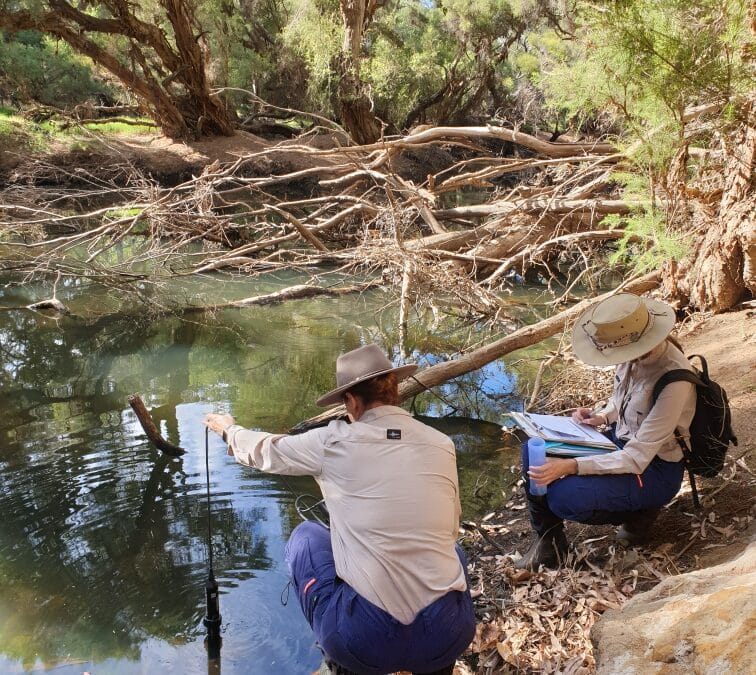
The Murray and Serpentine Rivers are vital ecosystems, providing life and resources to our native flora and fauna, as well as our community. There are over 4,000 km of natural and artificial waterways throughout the Swan Coastal Plain, and only 1% are in near pristine condition. The team at PHCC is on a mission to improve the health of more of our waterways so that we have healthy and productive rivers leading into our Ramsar listed Estuary.
To improve the health of the rivers we first need to understand them and the priority management actions needed. The need to preserve and conserve the ecological condition of the Murray and Serpentine is being addressed through the preparation of detailed River Action Plans (RAP) that identify and prioritise key assets, attributes and threats to these rivers as well as proposing restoration activities to help fix the damage.
The Murray River is the largest river in the Peel-Harvey Catchment encompassing an area of approximately 8,300 km2. The land around the Murray River, with its fine sedimentary soils that support cattle grazing, an abundance of fresh water and the ability for it to be used as a freight route, meant that the Murray was a major asset for European Settlement in the 1800’s. Since then, the river and neighbouring wetlands have suffered from major clearing and degradation through agricultural practices and urban development.
The Serpentine River is located in the South West region of Western Australia and covers an area of 664 km2. Much like the Murray, since European settlement the Serpentine River and surrounds have been significantly altered due to changing land uses and heavily modified drainage systems, resulting in the loss of wetlands, habitat and a highly eutrophic river and estuarine system through excess nutrient run-off.
Funded by the Alcoa Foundation, the development of the River Action Plans are key to helping the Serpentine and Murray rivers now and into the future. The Waangaamaap Bilya Serpentine River Action Plan was published in 2020 through the ‘Connecting Corridors and Communities; Restoring the Serpentine River’ project. PHCC is proud to announce the recently completed and published Bilya Maadjit Murray River Action Plan through the ‘Healing Bilya-Restoring the Murray and Serpentine Rivers’ project. The plans inform and prioritise on-ground actions and are a vital source of information for government departments and non-government organisations like PHCC, when planning works along the river into the future. These plans have been achieved in partnership with Urbaqua Ltd through detailed assessments of the vegetation, geomorphology, aquatic habitat and water quality of the river.
The Alcoa Foundation is the global charity of local bauxite miner and alumina producer Alcoa. Alcoa Foundation Australian Lead Suellen Jerrard said these river action plans provided a vital insight into the health of these important waterways. “The Alcoa Foundation recognise these waterways are the Peel region’s environmental, economic, cultural and social lifeblood and the information gathered through these health assessments can drive targeted action to ensure they can continue to play that important role for future generations. The Alcoa Foundation is proud to have played a key role in collecting this important snapshot and is keen to understand how it can support follow up work.”
The Murray River Plan focuses on two main areas, the Lower Murray River and the Middle Murray River. This is due to the complexity and nature of the waterway which includes heavy urbanisation in the lower sections and large-scaled rural properties sitting amongst the middle areas. The Middle Murray begins at the headland of the Darling Scarp and includes the area that flows down to the Pinjarra Weir. The Lower Murray study area starts at the Pinjarra Weir and through meandering channels and unique islands, concludes at the Ramsar listed Peel-Harvey Estuary, a wetland of international importance. The ~50km stretch was assessed by the project team on foot and by boat (complements of the Department of Water and Environmental Regulation).
All waterways are sacred to the Bindjareb Noongar people where their ongoing spiritual, cultural and intellectual connections to the land are strong and provide opportunities to work together to enhance the ecological condition of the streams, rivers and the Peel-Harvey Estuary. The word ‘Bilya’ is the Noongar name for river and also means umbilical cord. As spoken by local Noongar Elders, the Bilya sustains life for humans as well as land and aquatic ecosystems therefore, the healthier the river, the healthier life is for all.
PHCC’s Chair Caroline Knight expressed her thanks for this collaborative approach that is enabling future planning for on-ground action. ‘’We will use the River Action Plans to guide us in our future restoration works for the Serpentine and Murray rivers. By setting a baseline for the current condition of the river, the plans will enable us to measure the improvement in river health as a consequence of our actions. Improvements in condition of the Murray River will also complement PHCC’s efforts in protecting the values of the Peel-Harvey Estuary. The Estuary is a major component of the Peel-Yalgorup Wetlands System, recognised under the Ramsar Convention as a Wetland of International Importance due to the habitat it provides for waterbirds including migratory shorebirds, fish and invertebrates and threatened ecological communities’’ Peel-Harvey Catchment Council’s Chair Caroline Knight said.
The PHCC Waterways Team has already hit the ground running with undertaking on-ground actions to help improve the condition of both the Murray and Serpentine rivers. This includes revegetation, biosecurity control, fencing and bank stabilisation works in collaboration with stakeholders and the local community. Actions for 2023 are already being planned.
If you would like to learn more about the ‘Healing Bilya’project and what else is happening in and around the our waterways, please head to the PHCC Website.
This project is supported by the Peel-Harvey Catchment Council through funding from the Alcoa Foundation’s Three Rivers One Estuary Initiative.
ENDS Media Contact: Jane O’Malley, Chief Executive Officer, Peel-Harvey Catchment Council, Jane.Omalley@peel-harvey.org.au, (08) 6369 8800
